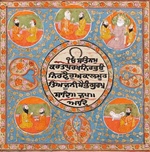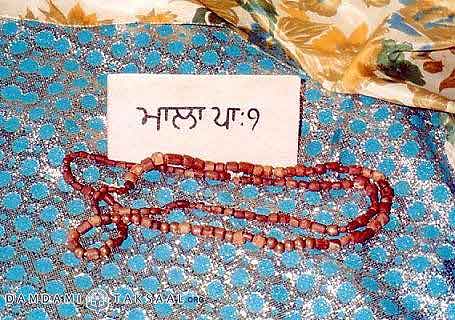by SS Siri Ved Kaur Khalsa, Bakersfield CA
Fall 2009
Bani, Bana, Seva, Simran. All the technology we need is found within these four gifts. Through the practice of Bani, we experience Shabd Guru and transform our every molecule. Through Bana, we augment our auras, project Guru’s radiance and, in fact, represent the Guru through our actions and words. Our turbans hold our heads “together,” protect our solar centers at our crown from the direct rays of the sun, and our coiled hairs, literally our built-in battery center.
Through the practice of Seva we learn to give up our heads, our egos, and surrender our Selves to be channels for Guru’s will, God’s will, not “my” will, and wash away the karmas/sanskaras of lifetimes.
Through Simran, that meditation through which one can change the destiny written on the forehead, we do just that; we free ourselves of destructive patterns, rewire neural pathways, change our way of thinking (pratyahar), turning negative to positive, and come to live in the neutral state of sahaj.
Guru gave this all to us, and more, in these four words, these four concepts that, when practiced and lived, give one the living experience of being a pure, learning, expansive soul, which is part of that Infinite Wondrous Oneness that we call God.
JapJi Sahib is Guru Nanak’s most beautiful and transformational gift, the key to opening doors to the Unknown, the key to Siri Guru Granth Sahib Ji, and a simple, divine, beautiful prayer. Dive in and drink its nectar!
Doing JapJi Malas
Here is my experience of Bani technology put into practice, when I completed three JapJi Malas over a period of nearly three years.
The 2003 and 2004 JapJi courses in Espanola were among the most potently transformational courses I have ever attended. Completely immersed in JapJi Sahib, in Guru’s sacred bani, we few hundred souls breathed JapJi Sahib, whispered JapJi Sahib, recited JapJi Sahib, sang JapJi Sahib, and meditated on JapJi Sahib. We delved into the meaning of JapJi Sahib, submerging ourselves deeply into the well of knowledge contained there, and we each emerged with a new understanding.
 Among the printed materials we received was a list describing the benefits of reciting each individual pauri. When you add the beginning and ending sloks with the 38 pauris, there are actually 40 pauris, or steps, to JapJi Sahib. Each of them, when recited individually as a meditation, has a uniquely transformational effect. Ideally, you will recite the desired pauri(s) 11 times a day, for 40 days, to experience some of that effect.
Among the printed materials we received was a list describing the benefits of reciting each individual pauri. When you add the beginning and ending sloks with the 38 pauris, there are actually 40 pauris, or steps, to JapJi Sahib. Each of them, when recited individually as a meditation, has a uniquely transformational effect. Ideally, you will recite the desired pauri(s) 11 times a day, for 40 days, to experience some of that effect.
Recognizing some areas of my own that could use such transformation, I read through the list carefully, thinking I would pick out a few pauris to help with my few “problem” areas. However, reading through the list and all of the benefits, I realized that in truth I needed to meditate on every single one of those pauris. I could not possibly choose one over another. I decided to gradually go through the entire JapJi, doing a few pauris at a time, 11 times each for 40 days. I figured it would take me about a year.
As soon as I got home I began my first 40 days, starting at the beginning with the Mul Mantra (opening slok) and the first 2 or 3 pauris. Then the next 40 days with the next several, and so on. I completed my first JapJi Mala just before the 2004 JapJi course, which I also attended.
The Cherdi Kala Jatha led a segment of that course where they talked about how the 40 pauris can be broken up into eight sections of 5 pauris each, and how those eight sections correspond to the eight chakras. They suggested reading five pauris at a time, 11 times each for 40 days. I immediately started another round of what I call JapJi Mala, dividing it up this way. I ended up, within a period of about three years, doing three complete JapJi Malas. Now, let me tell you the experience of it.
Counting Recitations
First of all, it was almost impossible for me to keep an accurate count of how many recitations I was doing. You might think counting to 11 is no big deal. However, I’d get so immersed in it, that after two or three times I was rarely ever certain if it had been two or three, so I’d do an extra, and then I wouldn’t be sure if it had been four or five, so I’d do another, and so on. I am sure I must have done way more than 11 on many occasions.
 I found the perfect solution to this problem. On a trip to India later that year I had a beautiful little mala made by the palmist in Rishikesh, made of 11 large lapis beads. This little mala made all the difference in the world. I still have those beads, which still hold all those recitations like a small precious treasure.
I found the perfect solution to this problem. On a trip to India later that year I had a beautiful little mala made by the palmist in Rishikesh, made of 11 large lapis beads. This little mala made all the difference in the world. I still have those beads, which still hold all those recitations like a small precious treasure.
Second of all, this is a wonderful way to memorize JapJi Sahib, if you have not already. Many times, I would recite in Gurmukhi, but read the English translation.
I developed a relationship with each pauri, its meaning and its rhythm. Some came to me melodically and I sang them as shabds. Others, such as the 23rd, repeatedly took me on “journeys” where I lost sense of time and space and became simply submerged, merged, in the sacred naad.
During those years I felt as though molecule by molecule I was being transformed. My old cloak of limiting consciousness, negative thought patterns, insecurity, basically, lifetimes of accrued crap, began to finally disintegrate.
I became aware of standing on a threshold to something new and unknown. I could not see through, but I knew without a doubt JapJi Sahib was the force propelling me forward. Whatever the pauris were that I was currently reciting, they stayed with me every moment of the day, in the background, processing continually, altering neural pathways, adjusting thought frequencies, whatever you want to call it.
Honest to God, I felt my true Self emerging like a blossoming lotus from a murky pool. Whether I completed my daily recitation as part of my morning Sadhana, driving in my car, cooking dinner, or just before sleep, as soon as I would begin it was like falling in love again, stepping into a divine groove, a sacred room, where JapJi and I, Guru Nanak and I, were One.
Author’s Note: I always did one pauri at a time, which allows you to really dive deeply into that pauri. I think it is really the best way. When Cherdi Kala Jatha talked about it, they also said to insert a full Mul Mantra in between each recitation (so if you were doing 11 of a specific pauri, you’d also be doing 11 Mul Mantras). I did that ONCE with five pauris. It was very powerful this way, but also took so long. What I ended up doing was a Mul Mantra at the beginning, in between each different pauri, and at the end (total of six), and I really like that a lot.
Meditating on the effects is definitely helpful, and easier to do when you are doing a specific pauri for a purpose. For instance, if you are working on surrender to the Will of God, you could meditate on that while reciting the 12th pauri. I found that harder to do doing multiples at a time.
About the Author
 SS Siri Ved Kaur Khalsa is an ordained Sikh Dharma Minister. Siri Ved Kaur is one of the earliest students of Yogi Bhajan, and was member of the Guru Ram Das Ashram community in Los Angeles for 35 years before moving to Central California in 2008. She remains active in leadership, women’s groups, and teaching courses and workshops on Yogic Diet and Cooking, Gurmukhi Alphabet and Pronunciation, Naad Yoga and Mantra Pronunciation, and Gurbani Kirtan. She is the author of the yogic cookbook From Vegetables with Love.
SS Siri Ved Kaur Khalsa is an ordained Sikh Dharma Minister. Siri Ved Kaur is one of the earliest students of Yogi Bhajan, and was member of the Guru Ram Das Ashram community in Los Angeles for 35 years before moving to Central California in 2008. She remains active in leadership, women’s groups, and teaching courses and workshops on Yogic Diet and Cooking, Gurmukhi Alphabet and Pronunciation, Naad Yoga and Mantra Pronunciation, and Gurbani Kirtan. She is the author of the yogic cookbook From Vegetables with Love.



